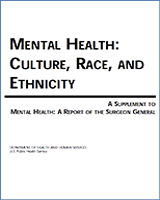From: Chapter 1. Introduction

NCBI Bookshelf. A service of the National Library of Medicine, National Institutes of Health.
| ECA Prevalence (%) | NCS Prevalence (%) | Best Estimate **(%) | |
|---|---|---|---|
| Any Anxiety Disorder ECA | 13.1 | 1 8.7 | 16.4 |
| Simple Phobia | 8.3 | 8.6 | 8.3 |
| Social Phobia | 2.0 | 7.4 | 2.0 |
| Agoraphobia | 4.9 | 3.7 | 4.9 |
| GAD | (1.5)* | 3.4 | 3.4 |
| Panic Disorder | 1.6 | 2.2 | 1.6 |
| OCD | 2.4 | (0.9)* | 2.4 |
| PTSD | (1.9)* | 3.6 | 3.6 |
| Any Mood Disorder | 7.1 | 11.1 | 7.1 |
| MD Episode | 6.5 | 10.1 | 6.5 |
| Unipolar MD | 5.3 | 8.9 | 5.3 |
| Dysthymia | 1.6 | 2.5 | 1.6 |
| Bipolar I | 1.1 | 1.3 | 1.1 |
| Bipolar II | 0.6 | 0.2 | 0.6 |
| Schizophrenia | 1.3 | - | 1.3 |
| Nonaffective Psychosis | - | 0.2 | 0.2 |
| Somatization | 0.2 | - | 0.2 |
| ASP | 2.1 | - | 2.1 |
| Anorexia Nervosa | 0.1 | - | 0.1 |
| Severe Cognitive Impairment | 1.2 | - | 1.2 |
| Any Disorder | 19.5 | 23.4 | 21.0 |
* Numbers in parentheses indicate the prevalence of the disorder without any comorbidity. These rates were calculated using the NCS data for GAD and PTSD, and the ECA data for OCD. The rates were not used in calculating the any anxiety disorder and any disorder totals for the ECA and NCS columns. The unduplicated GAD and PTSD rates were added to the best estimate total for any anxiety disorder (3.3%) and any disorder (1.5%).
** In developing best-estimate 1-year prevalence rates from the two studies, a conservative procedure was followed that had previously been used in an independent scientific analysis comparing these two data sets (Andrews, 1995). For any mood disorder and any anxiety disorder, the lower estimate of the two surveys was selected, which for these data was the ECA. The best estimate rates for the individual mood and anxiety disorders were then chosen from the ECA only, in order to maintain the relationships between the individual disorders. For other disorders that were not covered in both surveys, the available estimate was used. Key to abbreviations: ECA, Epidemiologic Catchment Area; NCS, National Comorbidity Survey; GAD, generalized anxiety disorder; OCD, obsessive-compulsive disorder; PTSD, post-traumatic stress disorder; MD, major depression; ASP, antisocial personality disorder.
Table reprinted from Mental Health: A Report of the Surgeon General, DHHS, 1999.
From: Chapter 1. Introduction

NCBI Bookshelf. A service of the National Library of Medicine, National Institutes of Health.